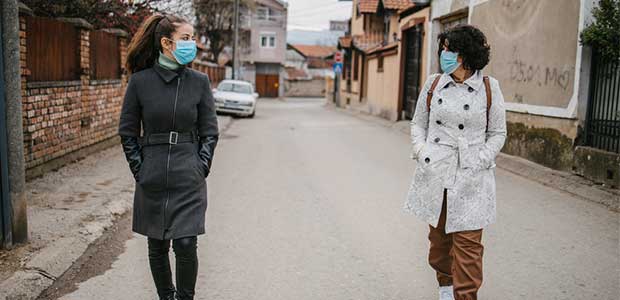
A COVID Analysis Goes Viral: How the Virus Spreads Indoors, Outdoors and in Other Spaces
One Dartmouth Professor and scientist’s blog post on the science behind the coronavirus and what it takes to get infected has gone viral—and the explanations are straightforward and easy to understand.
It takes as few as 1,000 SARS-CoV2 viral particles to infect someone with the coronavirus. That is based on the MERS and SARS outbreaks.
A single breath releases 50 to 50,000 droplets. If a person coughs or sneezes, 200,000,000 viral particles go everywhere.
At the start of this year, University of Massachusetts Dartmouth Professor Erin Bromage chose the pathogen emerging in China for his class to study. Now, after a pandemic has taken hold of the world and scientists are working to understand the novel coronavirus, Dr. Bromage’s blog post on the virus has gone viral.
The blog post, titled “The Risks—Know Them—Avoid Them,” is an impressive analysis of citations, graphics, research and statistics to help readers understand the coronavirus—and it is incredibly accessible and easy to understand.
The New York Times even caught wind of it and wrote, “By now, a friend may already have forwarded you a much-discussed blog post from a biologist named Erin Bromage—it has more than six million views. It’s an impressively clear explanation of how the virus often spreads inside confined spaces, like restaurants, churches, workplaces, and schools.”
The blog post discusses how the virus spreads with a simple equation: successful infection = exposure to virus + time.
He then explains how that formula works in various settings including the outdoors, public transit and restaurants. He addresses simple questions with very straightforward answers including: Where are people getting sick? How much Virus is released into the environment? What is the role of asymptomatic people spreading the virus? He also discusses the commonality of outbreaks and shares his personal reactions to openings up the economy and public spaces.
An infected person can infect another person just by breathing. And if he or she coughs or sneezes? Many people will likely get infected very quickly. One image from GV Wire exemplifies how important it is the contain your germs with a mask:

“Your sneezes and your coughs expel so much virus that you can infect a whole room of people,” said Dr. Bromage.
A cough releases about 3,000 droplets, and droplets can travel up to 50 miles per hour. A sneeze releases about 30,000 droplets, and droplets can travel at nearly 200 miles per hour. Speaking, Dr. Bromage says, increases the release of respiratory droplets about 10-fold from just breathing. When a person speaks, they release nearly 200 particles per minute. Therefore, scientists agree that it would take about five minutes of speaking with someone face-to-face to receive the required dose of particles to get infected.
While scientists are still studying the coronavirus, they are using influenza and similar viruses (SARS and MERS) as guides.
Keeping the successful infection = exposure to virus + time formula in mind, the blog post breaks down a number of environments and the risk of infection in each.
The outdoors, for example, are relatively safe spaces; restaurants, public transit and others are not. Why? The answer has to do with air flow and ventilation (and the formula).
Dr. Bromage discusses how places like restaurants, birthday parties, funerals, public transit, gyms and other spaces with indoor or poor ventilation are breeding grounds for the virus. People are in close quarters with one another for long periods of time. The virus travels through the air from people’s breathing, talking, coughing, sneezing and air ventilation systems. Not to mention, these spaces have shared surfaces like doorknobs and elevator buttons that spread the virus.
Running, walking or cycling outside, however, is a relatively low-risk. The outdoor air is well circulated, and if you are passing someone on a path, you should keep your distance still, but you are likely not being exposed to their particles for long enough to get infected. He references one Vox article that further explains this.
Let’s not forget, too, that the doctor’s claims are founded in science and studies. He shares studies and examples of workplaces, restaurants and venues where one infected person infected many others.
The restaurant study pulls from one focusing on air condition in a restaurant in China. It is published on the CDC’s website, and Dr. Bromage’s post even includes a graphic to demonstrate. One infected person in a restaurant ended up infecting half of his party sitting at the table and many other individuals in the restaurant—just through breathing air flow and air condition ventilation.

Make sure to check out Dr. Bromage’s blog post for a comprehensive view at the science, studies and graphics he has compiled. It’s crucial to understanding the risks of the virus and avoiding them—especially now that parts of the economy and workplace are beginning to reopen.
As he says at the end of his post, “As we are allowed to move around our communities more freely and be in contact with more people in more places more regularly, the risks to ourselves and our family are significant. Even if you are gung-ho for reopening and resuming business as usual, do your part and wear a mask to reduce what you release into the environment. It will help everyone, including your own business.”